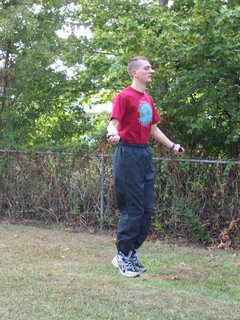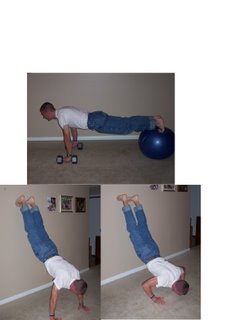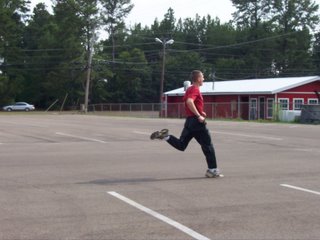Thursday 31 August 2006: CONDITIONING INTERVALS
- 10 minutes - 30/30 Jump Rope or Jumping Jacks
- 10 minutes - 30/30 Burpees
Intermediate:
- 10 minutes - 30/30 Jump Rope or Jumping Jacks
- 10 minutes - 30/30 Squat Thrusts
Basic:
- 10 minutes - 30/30 Jump Rope or Jumping Jacks
- 10 minutes - 30/30 Half-Squats
For a description of 30/30 intervals and the various exercises in today's workout, go here.
Post results to Comments.
Posted by
JME
at
20:20
4
comments
![]()
Wednesday 30 August 2006: PU ON THE MINUTE
Posted by
JME
at
19:25
4
comments
![]()
Topic: Bodybuilding - High Volume Push-ups
I hesitate to even use the term bodybuilding in the title of this article. Modern bodybuilding is a bloated, disgusting freak show full of steroid junkies with little or no real-world strength and endurance. Nevertheless, bodybuilding is what we are discussing, the natural development of the physique with function as our priority and form a distant second. To develop functional strength we need compound, strength-building movements performed at an aerobic pace to cultivate the muscular endurance required in the real-world. We also need anaerobic stimulation for cardiovascular fitness, HGH production, and additional endurance development. If you perform the Twenty Minute Fitness Solution Daily Workout on a regular basis, you will have each of the components for functional strength listed above. But what if you want to go to another level? What if you would like to add muscle mass or increase fat burning throughout the day? To accomplish these goals, we will add a simple technique using the greatest bodyweight exercise of all time: the push-up.
Posted by
JME
at
06:48
13
comments
![]()
Tuesday 29 August 2006: SPRINT PYRAMID
- 5 minutes - Run or Run-walk
- 10 seconds – Sprint
- 1 minute – Recovery
- 15 seconds – Sprint
- 1 minute – Recovery
- 20 seconds – Sprint
- 90 seconds – Recovery
- 30 seconds – Sprint
- 90 seconds – Recovery
- 20 seconds – Sprint
- 1 minute – Recovery
- 15 seconds – Sprint
- 1 minute – Recovery
- 10 seconds – Sprint
- 1 minute – Recovery
- 5 minutes - Run or Run-walk
Post results to Comments.
Two Fascinating Articles on the Aerobic (Endurance) Benefits of Sprint Training
The Surprising Aerobic Benefit of Sprinting
More Research on the Aerobic Benefit of Sprinting
Exerpt:
Summary
Six sessions of 30 second, all-out sprints over a two week period resulted in a doubling of endurance time to exhaustion and an impressive increase in muscle oxidative potential. These results stand in stark contrast to the traditional physiological explanation for the need for a base building phase and also challenge the belief that anaerobic exercise diminishes or negates the positive effects of aerobic training. The 100% improvement in endurance capacity shows that anaerobic training (i.e. sprints) can dramatically improve aerobic capacity and exercise performance in events that are primarily aerobic in nature.
Posted by
JME
at
18:58
4
comments
![]()
Monday 28 August 2006: 30/30 CALISTHENICS
30/30 CALISTHENICS
Today's workout uses the now familiar 30/30 work pattern (30seconds work, 30 seconds rest, repeat) to perform four different strength building exercises.
Advanced:
- 5 minutes - 30/30 Pull-ups and/or Chin-ups
- 5 minutes - 30/30 Sit-ups and/or Leg Levers
- 5 minutes - 30/30 Push-ups
- 5 minutes - 30/30 Squat Jumps
Intermediate:
- 5 minutes - 30/30 Assisted or Partial Pull-ups/Chin-ups
- 5 minutes - 30/30 Sit-ups or Crunches
- 5 minutes - 30/30 Push-ups (go to your knees if necessary)
- 5 minutes - 30/30 Bodyweight Squats
Basic:
- 5 minutes - 30/30 Body Rows
- 5 minutes - 30/30 Crunches
- 5 minutes - 30/30 Knee or Countertop Push-ups
- 5 minutes - 30/30 Half Squats
Post results to Comments.
Posted by
JME
at
18:12
7
comments
![]()
Saturday 26 August 2006: RUN FOR DISTANCE
RUN FOR DISTANCE
Advanced:
Run twenty minutes for distance
Intermediate:
Run-walk twenty minutes for distance
Basic:
Powerwalk hill repeats
Post results to Comments.
Got a Sledgehammer and 14 Minutes?
Posted by
JME
at
21:15
1 comments
![]()
Friday 25 August 2006: PULL-UP LADDERS + PU
- Ladders of Pull-ups/Chin-ups
- Sets of Regular Push-ups
Intermediate and Basic:
- Ladders of Partial or Assisted Pull-ups or Body Rows
- Sets of Regular, Knee, or Countertop Push-ups
Post results to Comments.
Posted by
JME
at
20:29
2
comments
![]()
Thursday 24 August 2006: 30/90 SPRINTS
30/90 SPRINTS
Perform today's sprints with progressive intensity, i.e. Sprint 1 - 70% of max effort, Sprint 2 - 80%, Sprint 3 - 90%, Sprints 4-5 - 100%.
Advanced:
- Run 5 minutes
- Repeat five times:
Sprint 30 seconds
Recover 90 seconds - Run 5 minutes
Intermediate:
- Run-Walk 5 minutes
- Repeat five times:
Sprint 15-30 seconds
Recover 90-105 seconds - Run-Walk 5 minutes
Basic:
- Power-walk 5 minutes
- Repeat five times:
Sprint 15 seconds
Recover 105 seconds - Power-walk 5 minutes
Post results to Comments.
Posted by
JME
at
18:29
4
comments
![]()
Wednesday 23 August 2006: PU DROP SETS
PU DROP SETS
Today's workout simulates an advanced weightlifting technique with push-up variations. Drop sets involve decreasing the amount of weight being lifted while continuing to crank out sets with little or no rest.
We will use a similar technique by supersetting three different push-ups variations of decreasing difficulty. To be effective, each exercise needs to push you without burning you out early in the session. Today's workout is supposed to be hard, but you should not be in a state of collapse five minutes into the workout.
Choose a rep range that will challenge you while permitting you to continue performing push-ups at the easier variations. Try to keep the number of reps the same in each superset. You may diminish the number of reps per set as the workout continues. Try to rest only between supersets (i.e. perform all three variations, then rest, then repeat). The recommended rep ranges are only guidelines. Choose the number of reps that is appropriate for your current level of strength and conditioning.
(For example: An advanced trainee might perform 15 push-ups with his feet elevated high on a wall, immediately drop into a regular push-up position and crank out 15 more reps, then drop onto his knees and crank out 15 more reps.)
Perform as many drop sets as possible in twenty minutes.
Advanced:
(Recommended rep range: 10-25)
- Feet Elevated Push-ups
- Regular Push-ups
- Knee Push-ups
Intermediate:
(Recommended rep range: 5-15)
- Regular Push-ups
- Knee Push-ups
- Countertop Push-ups
Basic:
(Recommended rep range: 5-10)
- Knee Push-ups
- Countertop Push-ups
- Countertop Push-ups (move feet closer to counter)
Post results to Comments.
Posted by
JME
at
18:42
6
comments
![]()
Tuesday 22 August 2006: B-CIRCUITS
B-CIRCUITS
Today's workout is based on a routine created by Bryce Lane. It is challenging but highly effective for developing the strength-endurance needed for real-world, functional fitness. Complete as many circuits as possible in twenty minutes. Remember to land lightly.
Advanced:
- 12 Short range Jumps
(Short range of motion, just jump as you would for a jump test) - 12 Full range Squat Jumps
(Jump from a full or three-quarter squat, a.k.a. star jump) - 20 Bodyweight Squats
(E.g. Hindu, Deep Knee Bend, Sumo, etc.)
Intermediate:
- 6 Short range Jumps
- 6 Medium-Full range Squat Jumps
(Jump from a half, three-quarter, or full squat depending on your ability) - 10 Bodyweight Squats
Trainees that are uncomfortable with or not conditioned for jumping exercises should perform the Basic circuit, even if they have previously completed Intermediate or Advanced workouts.
Basic:
- 5 Lunges each leg
(Step forward with hands on hips. Bend your front leg to a 90 degree angle; your rear leg should be bent with the knee close to the ground.) - 5 Heel Raises
(Stand with your feet slightly apart. Rise onto the balls of your feet and flex your calves.) - 5 Half-Squats
Post results to Comments.
Posted by
JME
at
19:44
5
comments
![]()
Monday 21 August 2006: TIMED SETS
TIMED SETS
Today's workout is ideal preparation for the PFT on the first Monday of every month.
- Max Pull-ups in 1 minute
- Max Pull-ups in 45 seconds
- Max Pull-ups in 30 seconds
- Max Pull-ups in 15 seconds
- Max Sit-ups in 1 minute
- Max Sit-ups in 45 seconds
- Max Sit-ups in 30 seconds
- Max Sit-ups in 15 seconds
- Max Push-ups in 1 minute
- Max Push-ups in 45 seconds
- Max Push-ups in 30 seconds
- Max Push-ups in 15 seconds
Insert one minute of rest between each set of exercises. Intermediate and Basic trainees should substitute (as necessary) Partial Pull-ups or Assisted Pull-ups or Body Rows for Regular Pull-ups, Crunches for Sit-ups, and Knee or Countertop PU for Regular Push-ups.
Post results to Comments.
Posted by
JME
at
20:22
4
comments
![]()
Topic: Weight Loss - No "S" Diet
A Common Sense Weight Loss Plan
Recently we posted an article on the Ten Simple Rules of Common Sense Nutrition. The Common Sense Nutrition Plan is not a diet that a person follows for a few weeks or months until they achieve their ideal bodyweight. In fact, Common Sense Nutrition is not a weight loss plan. It encourages a healthy approach to food that is simple to understand and can be utilized for a lifetime. If you are overweight, the Common Sense Nutrition Plan will help you shed those excess pounds. But what if you are significantly overweight, even obese, and need something more to help control your eating and kick-start your journey to better health and fitness? Losing weight is simple, but a lack of self-discipline makes it anything but easy for many people. If you are tired of fad diets that are gimmicky rather than logical and that quickly become monotonous, let me offer a common sense solution to your weight loss problem.
To lose weight, you must burn more calories than you consume. As long as you are eating excessively, you will have a hard time creating the necessary calorie deficit to burn bodyfat, no matter how much you exercise. To lose weight, you need to eat less and be physically active. That doesn’t require an aggressive exercise program, but it will require you to do more than sit on the couch and watch TV.
The No “S” Diet is the most common sense approach to controlled eating that I have ever seen. Best of all, information on the No “S” Diet is free - there are no books to read, tapes to listen to, or special foods to purchase. The No “S” Diet is a mnemonic device to help control food consumption. The plan is simple: No snacks, No sweets, No seconds, except (sometimes) on days that start with “S.” Sound too easy to be really effective? It works. It does not promise stunning, overnight results. The weight loss is gradual, as it should be. The plan develops a disciplined approach to eating that is sustainable for a lifetime. It focuses on how much you eat rather than what you eat, and it is perfectly compatible with the Common Sense Nutrition Plan’s guidelines for healthy food choices.
Most overweight people lack the self-discipline to truly overcome their problem with food. That’s right. I said weight issues are almost always a problem with food and self-discipline. No matter how society may try to excuse it, obesity is rising because people are indulging their appetite for highly refined, sugary foods in enormous quantities. To achieve and maintain a healthy bodyweight, you must learn to tell yourself “No.” You must exercise the physical restraint to push yourself away from the table and to refuse the hunger “itch” when it nags you to visit the refrigerator, pantry, or vending machine. Our society has grown accustomed to immediate gratification of any food craving, and we are fatter and unhealthier as a result.
Reinhard Engels, the creator of the No “S” Diet, recommends interested individuals try his diet for twenty-one days. During those three weeks, your body and mind will adjust to the more disciplined approach to eating, and you will have sufficient experience with the diet to begin seeing some initial results.
In addition to the No “S” Diet, I recommend that overweight individuals also build up to walking one hour every day. As we will discuss in a future article, walking is very efficient transportation but very inefficient exercise. For that reason, you must do more than stroll a few days a week to lose weight. Most people will be able to cover three to four miles walking for one hour. This increased physical activity will aid your body in burning fat and will help you achieve a healthy bodyweight.
For further reading:
- Check out the No "S" Diet Forum
- Check out this article on the mental discipline necessary for weight loss
Posted by
JME
at
15:41
2
comments
![]()
Saturday 19 August 2006: RUN FOR DISTANCE
RUN FOR DISTANCE
Advanced:
Run twenty minutes for distance
Intermediate:
Run-walk for twenty minutes
Basic:
Powerwalk hill repeats for twenty minutes
Post results to Comments.
Coolrunning.com's Couch to 5K Program
Posted by
JME
at
19:27
0
comments
![]()
Friday 18 August 2006: DIPS + CHIN-UPS
DIPS + CHIN-UPS
The tried and true superset for developing balanced upper body strength.
Pick a low number of reps for both parallel bar dips and chin-ups, then perform them back to back without rest. Only rest between "super sets" (i.e. one set of dips and one set of chins). Perform as many supersets as possible in twenty minutes. Your number of reps per set will likely change during the course of the workout. Start small at the beginning lest you burn yourself out early.
If you do not have access to parallel bars, you can perform bar dips on the backs of two sturdy chairs or at the corner of a countertop. Variations for intermediate and basic trainees consist of chair dips (with hands in the seat of two chairs and feet on the floor or elevated on a third chair), push-ups, knee push-ups, or countertop push-ups. Advanced trainees may substitute feet elevated push-ups for dips if necessary.
Intermediate and basic trainees should substitute partial chin-ups, assisted chin-ups, or bodyrows for regular chin-ups.
Post results to Comments.
Posted by
JME
at
20:04
5
comments
![]()
Thursday 17 August 2006: ANIMAL CONDITIONING

CONDITIONING - ANIMAL STYLE
Today's workout uses a variety of simulated animal movements to improve physical conditioning. This type of workout is especially fun for children, but I think even our more advanced trainees will find it sufficiently challenging.
Advanced:
- 5 minutes - 30/30 Tiger Prowl
(Crawl on your hands and feet keeping your body as low to the ground as possible without touching.) - 5 minutes - 30/30 Crab Crawl
(Sitting on the ground, bend your knees and place your feet flat on the ground and rest your hands on the ground slightly behind your hips. Lift your pelvis taking the weight of your body on your hands and feet, stomach pointing towards the sky. Crawl on your hands and feet.) - 5 minutes - 30/30 Kangaroo Hop
(Perform a half-squat and jump forward landing on your feet.) - 5 minutes - 15/45 Cheetah Sprint
(Sprint fast like a cheetah chasing a gazelle.)
Intermediate:
- 5 minutes - 30/30 Bear Crawl
(Bend forward and crawl on your hands and feet.) - 5 minutes - 30/30 Crab Crawl
(Sitting on the ground, bend your knees and place your feet flat on the ground and rest your hands on the ground slightly behind your hips. Lift your pelvis taking the weight of your body on your hands and feet, stomach pointing towards the sky. Crawl on your hands and feet.) - 5 minutes - 30/30 Walking Lunges
(Step forward and bend your knees. Your front knee should bend to a 90 degree angle; your back knee should bend to 90 degrees and stop just above the ground. Now step forward with the back leg and continue.) - 5 minutes - 15/45 Sprint
Basic:
- 5 minutes - 30/30 Bear Crawl (Go to your knees if necessary, but do so on a soft surface.)
(Bend forward and crawl on your hands and feet.) - 5 minutes - 30/30 Crab Crawl (Rest on your bottom if necessary.)
(Sitting on the ground, bend your knees and place your feet flat on the ground and rest your hands on the ground slightly behind your hips. Lift your pelvis taking the weight of your body on your hands and feet, stomach pointing towards the sky. Crawl on your hands and feet.) - 5 minutes - 30/30 Half-Squats
- 5 minutes - 15/45 Sprint or Powerwalk
Post results to Comments.
Posted by
JME
at
19:20
2
comments
![]()
Topic: Common Sense Nutrition
The Ten Simple Rules of Common Sense Nutrition
Never before has a society had so much available information on health, fitness, and nutrition, and never before has a society been so unhealthy, out of shape, and obese as ours has become. If you’re confused by the myriad of nutrition advice being provided in books, magazines, and on the airwaves today, and if you are interested in a common sense approach to eating that will help you lose weight, be healthier, and is sustainable for the rest of your life, let me recommend the following ten guidelines.
Eat in moderation
Moderation doesn’t refer to a specific amount of food or certain number of calories daily. Rather, it refers to a general attitude of restraint with regard to eating, an attitude that is content with a sufficient amount of food to support a healthy lifestyle. This amount will vary according to each individual’s circumstances. For instance, a marathoner with no excess body fat and running fifty miles per week will require more food to fuel his daily activities than a sedentary office worker who is fifty pounds overweight. Moderation means being able to stop when you feel full and slowing down long enough to determine when you reach that point. To eat in moderation means being able to resist the urge to get a second piece of cake and to choose extra steamed vegetables instead of additional mashed potatoes.
To eat in moderation, we need to be familiar with portion sizes. Some books and diet plans get very detailed in describing portion sizes, but we’re not interested in going on a diet, we are trying to adjust our eating habits for a lifetime of healthy eating. Most foods that you consume will fall into one of two categories: carbohydrate or protein. Carbohydrates are things like fruit, vegetables, bread, pasta and rice. These last three items are starches, and you will need to particularly control consumption of them if you hope to lose weight. Proteins are meat and eggs. A serving of carbs is roughly the size of your closed fist. A serving of protein is roughly the size of the palm of your hand.
A simple way of applying moderation in your eating habits is to divide your plate into fourths. Two-fourths (or half the plate) should be covered with fruits and vegetables. One-fourth of your plate should be set aside for protein, and the last fourth can be used for starches (e.g. bread, baked potato, or pasta). If you needs seconds because you still aren’t full, try to limit yourself to extra fruits and vegetables. Leave off extra starches. Additional protein is also acceptable, especially if you are in the habit of regular strength training.
Rarely consume empty calories
An empty calorie is any food or drink that serves no practical, nutritional purpose. This would include sodas which contain loads of sugar or sugar substitutes but fail to nourish or adequately hydrate the human body. Other examples of empty calories would be sugary breakfast cereals or candy bars. Many people in the South drink sweet tea throughout the day, but this is basically sugar water and does more harm to the body than good. Empty calories should be saved for cheat days (see rule #9) and special occasions. If you make a habit of regularly consuming these empty calories, they will likely catch up to you in the form of blood sugar problems, weight gain, and poor health.
Limit sweet and/or fatty desserts to one meal per week
This rule isn’t hard to understand. There is no reason to consume sweet, fatty desserts (e.g. cookies, cake, ice cream, etc.) more frequently than once per week.
Consume at least five servings of fruit and vegetables per day
My primary complaint about popular low-carb diets is their restriction on raw, unsweetened fruits and vegetables. No one ever became fat eating raw, unsweetened fruits and veggies. Yes, fruits and some vegetables contain natural sugars, but they also consist of wholesome fiber and the nutrients that God created our bodies to run on. There is no reason to restrict carb intake from fruits and vegetables. Only manmade, refined carbs need to be restricted.
Common sense nutrition allows for unlimited daily consumption of raw, unsweetened fruits and vegetables. That doesn’t mean unlimited consumption of a squash and cheese casserole, or broccoli dipped in cheese sauce, or cooked apples sweetened with sugar. Those items need to be consumed in careful moderation, and they may need to be eliminated from your diet for a time until a healthy bodyweight is achieved. But raw, unsweetened fruits and veggies can be eaten whenever your body craves a snack or seconds at a meal. And you can eat these foods guilt-free confident that you are doing something good for your body.
Try to consume five servings of fruits and vegetables each day. For instance, you might eat a banana with breakfast, an apple and a salad of greens at lunch, and at least two servings of other vegetables at dinner. Choose vegetables with a variety of colors too.
Seek out whole grains
For centuries, bread has been one of the staples of human diets. Unfortunately, modern man has become accustomed to highly refined breads and starches that raise blood sugar levels and offer very little nutritive value. Whenever you plan to eat starches, seek out whole grain sources which provide better nutrition than their highly refined counterparts. For example, next time you make spaghetti, try whole-wheat pasta instead of regular. You might mix both whole-wheat and regular pasta in your dishes until you adjust to the heartier flavor. Once you adjust, I think you will find the whole-wheat spaghetti far more flavorful and satisfying. When purchasing bread, buy a whole-grain variety instead of the white bread you normally buy, even if your white bread is “fortified with vitamins and minerals.” Be careful, because not all products advertised as wheat are much better than white. Look for whole-wheat or whole-grain as the first ingredient on the label, and seek out products with 2-2.5 grams or more of fiber per serving.
Choose lean meats
You don’t have to become a vegetarian in order to become a healthy eater; vegetarianism is not necessarily the healthiest approach to eating anyway. You can practice good nutritional habits and still consume animal meat on a regular basis. What is important is selecting leaner meats that offer a good source of protein with limited saturated fats and cholesterol. Fish, chicken, venison, turkey, and lean beef (e.g. ground chuck or ground round). You might limit red meat to two to four meals per week. Fattier meats like pork should be consumed on a less frequent basis. The way meat is prepared also affects its nutritional value. Avoid fried foods as much as possible. Don’t console yourself with the thought that fried chicken is a healthier meal than a lean hamburger. It would be better to eat the hamburger. Processed meats like sausage and hot dogs are full of fat and chemicals and are high in sodium. Processed meats should be a rare indulgence. If you are a heart patient, you need to eliminate fatty and processed meats from your diet.
Whenever possible, choose the healthier alternative
Learn to read food labels. Not all reduced fat or fat-free foods are good for you. Some contain extra sodium, sugar, or other chemicals that can be harmful in the long run. Many others, however, are preferable alternatives to high fat foods. Whenever possible, choose the healthier food option. For example, iceburg lettuce offers little in the way of nutrition, but green leaf lettuce, romaine lettuce, and spinach leaves are a great alternative for salads and side dishes, and they are more flavorful. Many low-fat or fat free salad dressings are good alternatives to high fat versions. If you can, order grilled chicken instead of fried, wholegrain bread instead of white, and a yogurt parfait instead of French fries. Choosing the healthier alternative is a general principle to remember whenever you’re about to eat a meal or snack. By applying this simple rule, you can make good choices about your food and drink and enjoy it guilt-free knowing that your decision was consistent with a healthier lifestyle.
Drink lots of water
Most people consume far too little water, especially during the heat of summer. Soda, tea and coffee cannot substitute for the hydrating goodness of water. Basic tap water is a perfectly acceptable source of drinking water in most places in the U.S., or you can buy a filtered water pitcher or water purifying system. Most humans need at least two quarts of water per day, and that daily amount should be increased if you spend time in the heat or engage in vigorous exercise. Two quarts of water is not as much as you may think. Get two one-quart water bottles, and fill each of them at the beginning of the day. Keep a bottle with you throughout the day, and sip from it regularly. Many people live in a constant state of mild to moderate dehydration. But adequate water consumption has so many benefits and is so easy to obtain, there is no reason not to get enough water during most days. Drink water with every meal. If you need to lose weight, drink a glass of water before to sit down to eat each meal. Increasing daily water intake is a simple but powerful tool to increase fat loss.
Give yourself one (reasonable) cheat day per week
Nobody enjoys a restrictive diet that makes them feel miserable when they follow it and guilty when they don’t. This is a major reason why most people are unsuccessful at losing weight long-term on a highly restrictive diet plan. But we’re talking about common sense nutrition, and common sense dictates periodic, reasonable indulgences in what we eat. After all, common sense nutrition is about an approach to healthy eating that will last a lifetime. Most of us don’t want to forgo ice cream sundaes or brownies forever.
One day per week, indulge yourself with a reasonable allotment of some of the foods you have avoided the other six days. Reasonable does not mean eating an entire large, deep dish pizza. Nor does reasonable include eating the entire half-gallon of ice cream in a twenty-four hour period. But if you want a burger and fries with a milkshake, okay. If you want to order pizza with your movie, go ahead. Remember not to entirely abandon the concept of moderation, but enjoy the food that you eat without feeling guilty. Once your body has adjusted to a healthy eating plan, you may find that these cheat days leave you feeling a bit run down. The additional energy and health that you will feel while adhering to sound, nutritional principles will make you even more motivated to eat healthy, and your cheat days will sometimes serve as a reminder of how bad you used to feel. Even so, enjoy your cheat days. They are important for long-term success.
Exercise four to six days per week
No, exercise is not a nutritional guideline, but it is a critical component in achieving and maintaining good health. To lose weight, you must burn more calories than you consume. The best plan for long-term weight loss combines healthy eating with increased physical activity. But exercise isn’t just for people who need to lose weight; a habit of exercise is for everyone. You don’t have to join a gym, lift weights, or run marathons to get the exercise you need. Go for a brisk walk of thirty to sixty minutes; perform calisthenics at home; or purchase an exercise video that you might enjoy doing three or four days per week. Exercise doesn’t have to be strictly formal sessions either. You can increase your daily physical activity level by taking the stairs instead of the elevator, parking your car at the back of the parking lot instead of finding a spot close to the front, performing small sets of push-ups every hour or two throughout your day, or taking your kids to a local park and running and playing along with them. Find a way to make exercise fun, and you will be more likely to stick with it long-term.
Occasionally we all fall back into bad habits, we sneak a brownie or have an extra helping of those creamy mashed potatoes or over-indulge on pizza night. When that happens, do not despair. Everyone has setbacks; we are pursuing a pattern of healthy eating for life. Your weakness will not be life-threatening, unless it becomes habitual. You may have fallen into bad habits because you kept the wrong kinds of foods in your house. Get rid of them. Don’t tempt yourself by keeping ice cream in the freezer and cookies and chips in the pantry. Maybe you have been skipping your cheat days. Don’t, they are important for long-term success. Perhaps you simply haven’t been enjoying your daily meals because you haven’t explored a sufficient variety of food options. The possibilities are endless. Don’t be afraid to try new dishes and use new foods. Good nutrition isn’t rocket science. With a little education, a modest amount of self-discipline, and consistent practice, healthy eating is as simple as common sense. -JME
Posted by
JME
at
20:13
7
comments
![]()
Wednesday 16 August 2006: PU + ABS SUPERSETS
PU + ABS SUPER SETS
Perform as many rounds as possible in twenty minutes.
Advanced:
- 10-25 Push-ups
(you choose the variation: e.g. wide, narrow, elevated, Hindu, etc.) - 10-25 Abs
(you choose the exercise: e.g. sit-up, leg lever, bicycle, V-up, etc.)
Intermediate:
- 5-15 Push-ups
(go to your knees as necessary) - 5-15 Abs
(you choose the exercise: e.g. sit-up, crunch, leg lever, bicycle, etc.)
Basic:
- 5-10 Knee or Countertop PU
- 5-15 Abs
(you choose the exercise: e.g. sit-up, crunch, leg lever, bicycle, etc.)
Post results to Comments.
Here are a couple of articles on diet soda consumption. I do not recommend diet sodas as a beverage. In fact, if you're going to indulge in a soft drink, you'd be better off drinking a regular soda.
http://www.foxnews.com/story/0,2933,159579,00.html
http://www.mercola.com/2005/jun/30/diet_sodas.htm
Posted by
JME
at
19:10
6
comments
![]()
Tuesday 15 August 2006: CONDITIONING INTERVALS
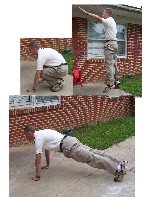
CONDITIONING INTERVALS
Today's conditioning intervals employ 30/30 work patterns (30 seconds work, 30 seconds rest, repeat) and 15/45 work patterns (15 seconds work, 45 seconds rest, repeat).
Advanced:
- 5 minutes - 30/30 Jump Rope or Jumping Jacks
- 5 minutes - 30/30 Burpees
- 5 minutes - 30/30 Squats
- 5 minutes - 15/45 Sprints
Intermediate and Basic:
- 5 minutes - 30/30 Jump Rope or Jumping Jacks
- 5 minutes - 30/30 Squat Thrusts
- 5 minutes - 30/30 Squats or Half-Squats
- 5 minutes - 15/45 Sprints
Post results to Comments.
Do Not Confuse Strength With Conditioning
Though written for boxers and mma competitors, this article is equally applicable to dads, moms, and anyone who finds himself challenged by the demands of a long and strenuous day.
Posted by
JME
at
20:00
4
comments
![]()
Monday 14 August 2006: SPARTAN RUN
SPARTAN RUN
Complete as many rounds as possible in twenty minutes.
Advanced:
- 5+ Pull-ups/Chin-ups
- 10-20 Push-ups
- 15-25 Abs (you pick: crunch, leg lever, sit-up, etc.)
- Run 1/4 mile
Intermediate:
- 5 Assisted or Partial Pull-ups or Body Rows
- 10 Push-ups (go to your knees if necessary)
- 15 Abs (you pick: crunch, leg lever, sit-up, etc.)
- Run-Walk 1/4 mile
Basic:
- 5 Body Rows
- 5 Knee Push-ups
- 10 Abs (you pick: crunch, leg lever, sit-up, etc.)
- Powerwalk 1/8 mile
Post results to Comments.
Posted by
JME
at
19:25
5
comments
![]()
Saturday 12 August 2006: RUN FOR DISTANCE

RUN FOR DISTANCE
Advanced:
Run twenty minutes for distance.
Intermediate:
Run-Walk twenty minutes for distance, OR Powerwalk hill repeats for twenty minutes.
Basic:
Powerwalk twenty minutes for distance.
Post results to Comments.
Posted by
JME
at
09:41
0
comments
![]()
Friday 11 August 2006: PULL-UPS ON THE MINUTE

PULL-UPS ON THE MINUTE
Perform a set of pull-ups/chin-ups at the top of every minute for twenty minutes.
Intermediate and Basic trainees should subsitute partial reps, assisted reps, and/or bodyrows as necessary.
Post results to Comments.
You think you're good at pull-ups?
Posted by
JME
at
15:05
3
comments
![]()
Thursday 10 August 2006: SPRINTING
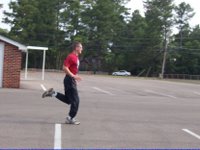
SPRINTING
Today's workout is the now familiar "30/90 Sprint."
Advanced:
- Run 5 minutes
- Repeat five times:
Sprint 30 seconds, Rest 90 seconds - Run 5 minutes
Intermediate:
- Run/Run-walk 5 minutes
- Repeat five times:
Sprint 30 seconds, Rest 90 seconds - Run/Run-walk 5 minutes
Basic:
- Powerwalk 5 minutes
- Repeat five times:
Sprint 15 seconds, Rest 105 seconds - Powerwalk 5 minutes
I recommend using a progressive sprint pattern. Sprint 1 would peak at 70% of maximum, sprint 2 at 80%, sprint 3 at 90%, and sprints 4-5 would be 100% efforts. Remember that max speed for a 30 second sprint is different than the speed for a 6 second sprint! Hydrate well, and avoid running these sprints in the heat of the day.
Post results to Comments.
For those who may be interested, here is information on a study demonstrating the superiority of 30 second sprints over 6 second sprints in stimulating the natural production of human growth hormone.
Posted by
JME
at
19:18
4
comments
![]()
Wednesday 9 August 2006: PU ON THE MINUTE
Posted by
JME
at
18:48
6
comments
![]()
Tuesday 8 August 2006: 30/30 SQUATS

30/30 SQUATS
Land lightly on the jump squats; your knees will thank you.
Advanced:
- 10 minutes - Jump Squats (any style, e.g. Jump-ups or Jump-overs)
- 10 minutes - Bodyweight Squats (any style)
Intermediate:
- 10 minutes - Jump Squats
- 10 minutes - Bodyweight Squats (any style)
Basic:
- 5 minutes - Jump Squats (two footed jumps over a shoe)
- 5 minutes - Half Squats
- 5 minutes - Jump Squats (same as above)
- 5 minutes - Half Squats
Though difficult, jump squats stimulate the natural production of human growth hormone which results in fat burning and muscle building.
Post results to Comments.
Posted by
JME
at
19:29
6
comments
![]()
Monday 7 August 2006: PFT
PHYSICAL FITNESS TEST
This PFT will be re-run on the first Monday of every month to provide trainees an objective means of testing their progress.
Advanced:
- Max Pull-ups or Chin-ups in 1 set
- Rest 1 minute
- Max Sit-ups in 1 minute
- Rest 1 minute
- Max Push-ups in 1 minute
- Rest 3 minutes
- Run 12 minutes for Distance
Intermediate:
- Max BodyRows in 1 set
(BodyRows: Also called horizontal pull-ups. See picture for Friday 4 August WOD.) - Rest 1 minute
- Max Crunches or Sit-ups in 1 minute
- Rest 1 minute
- Max Push-ups in 1 minute
- Rest 3 minutes
- Run-Walk 12 minutes for Distance
Beginner:
- Max Flexed Arm Hang or Hang from Bar
(Flexed arm hang: Hold yourself at the top of a pull-up bar for as long as possible. The exercise is completed when your arms straighten.) - Rest 1 minute
- Max Crunches in 1 minute
- Rest 1 minute
- Max Knee Push-ups in 1 minute
- Rest 3 minutes
- Powerwalk 12 minutes for Distance
Post results to Comments.
Posted by
JME
at
20:58
4
comments
![]()
Saturday 5 August 2006: RUN FOR DISTANCE
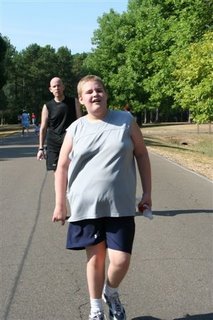
RUN FOR DISTANCE
Advanced:
Run for twenty minutes.
Intermediate:
Power-walk hill repeats for twenty minutes.
Basic:
Power-walk for twenty minutes.
Post results to Comments.
Good job this week. Rest well on Sunday. Your next PFT is coming up on Monday.
Posted by
JME
at
18:14
2
comments
![]()
Friday 4 August 2006: PULL-UP LADDERS + PU
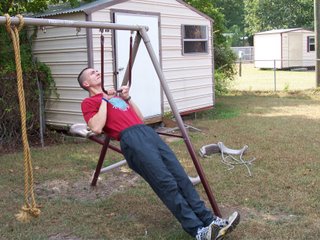
PULL-UP LADDERS + PU
For today's workout you will alternate sets of pull-ups or body rows with sets of push-ups. Your pull-ups/body rows will progress in ladder fashion beginning with one rep and adding an additional rep with each set; unlike pyramid training, you will not reverse your sets at the end of the workout. Instead, perform sets of pull-ups/body rows adding one rep to each set until you fail to complete a set. Then start again at one and continue building ladders until time expires (e.g. 1, 2, 3, 4, 5, 6, 4...1, 2, 3, 4, 4...1, 2, 3, etc.). Perform a set of 5-10 push-ups between each set of pull-ups/body rows. See how many reps you can perform this way in twenty minutes.
Advanced: Pull-up/Chin-up Ladders + 10 PU
Intermediate: Body Row Ladders + 5-10 PU or Knee PU
Basic: Body Row Ladders + Knee or Countertop PU
Post results to Comments.
Posted by
JME
at
18:06
4
comments
![]()
Thursday 3 August 2006: CRAWL...SPRINT!
CRAWL...SPRINT!
- Bear Crawl x 5 minutes
(30seconds work, 30 seconds rest, repeat for allotted time) - Sprint x 5 minutes
(15 seconds sprint, 45 seconds rest, repeat for allotted time) - Crab Crawl x 5 minutes
(30seconds work, 30 seconds rest, repeat for allotted time) - Sprint x 5 minutes
(15 seconds sprint, 45 seconds rest, repeat for allotted time)
See the July 20th workout for a description of Bear Crawls and Carb Crawls.
Post results to Comments.
Posted by
JME
at
18:32
2
comments
![]()
2 August 2006: PU + ABS SUPER SETS

PU + ABS SUPER SETS
Repeat as many cycles as possible in twenty minutes. Try to only rest at the end of each cycle.
Advanced:
- 10 Push-ups
- 10 Sit-ups
- 10 Narrow/Diamond Push-ups
- 10 Leg Levers
- 10 Wide Push-ups
- 10 Bicycle Crunches
Intermediate:
Same as advanced, but go to knees on the push-ups if necessary.
Basic:
- 10 Knee or Countertop Push-ups
- 10 Crunches
- 10 Narrow Knee or Countertop Push-ups
- 10 Reverse Crunches (Bring knees to chest)
- 10 Wide Knee or Countertop Push-ups
- 10 Bicycle Crunches
See the July 19th 2006 workout for descriptions of Leg Levers and Diamond PU.
Post results to Comments.
Posted by
JME
at
18:53
3
comments
![]()

